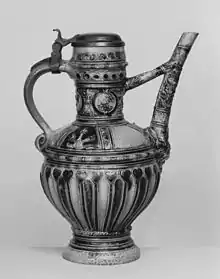Bridge-spouted vessel
A bridge-spouted vessel is a particular design of ewer (jug or pitcher) originating in antiquity; there is typically a connecting element between the spout and filling aperture, and the spout is a completely independent aperture from the usually smaller central fill opening. Early incidences of the bridge-spouted vessel are found in Persia in the early Iron Age[1] and on Crete. This type of vessel typically appears in the Bronze Age or early Iron Age. A very early example of a bridge-spouted bowl has been recovered at the ancient palace of Phaistos on Crete, dating to the Bronze Age.[2]


There is a different type, characteristic of the pottery of the Nazca culture of Pre-Columbian Peru, where two spouts rising vertically from the body of the vessel are linked by a bridge that apparently also served as a carrying handle.
References